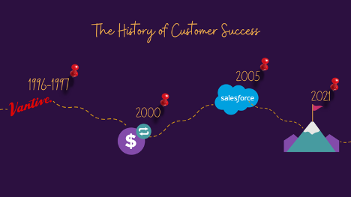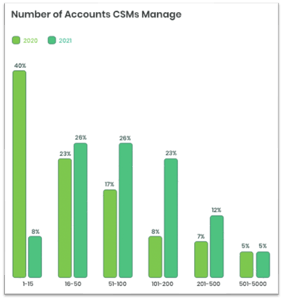The rise and (totally unnecessary) burnout of Customer Success
Have you ever stopped to consider the wonder that is a Customer Success Manager (CSM)? I mean, how do they make so many customers successful, anyway?
There are sooooooo many responsibilities for a CSM to manage. For instance, adding new accounts, building genuine relationships with each customer, keeping track of critical KPIs for each account, and on and on and on.
Certainly, building relationships with people can provide immense joy and fulfillment. But with all the additional responsibilities (and expectations), there’s a fine line between fulfillment and stress. And an even finer line between stress and burnout...
A brief history of Customer Success
Around 1996, a CRM company named Vantive jumpstarted modern day Customer Success (CS). Vantive’s CEO, John Luongo, discovered one of their customers was using their offering in a very innovative way.
Luongo wanted to find a way to capture these types of innovations and share them more broadly. So, Vantive created a dedicated department that was charged with asking customers two simple questions:
- How do you define your success?
- What do you expect from us?
They documented customers' expectations and then reviewed them together after 6 months. Seem familiar?
A few years later, after SaaS offerings began getting traction, the market saw a power shift from the vendor to the customer. As Adam Dorrell saw it,
SaaS had a problem; they were an industry that was based entirely on renewable subscriptions and yet their customers had the ability to be as fickle and disloyal as they wished.
This is when Customer Acquisition Cost (CAC) and Customer Lifetime Value (LTV) became so critical. People quickly realized the need to monitor and improve customer longevity, especially if it was costly to acquire new customers.
Around the same time, Customer Success began to be viewed as a critical function became even more important. For all the same reasons CAC and LTV were in vogue.
While the CS function has grown in popularity over the last 10 – 15 years, it has kicked into yet another gear of insanity since the start of the pandemic.
As stated in the Totango 2021 State of the Customer Success Industry & Salary Report, 66% of CSMs were responsible for at least 50 customer accounts. This number rose by 29% from the prior year!
As the need for and expectations of CS rise, the likelihood of CSM burnout increases.
Why burnout is very possible for CSMs
To make matters worse, because CS is a relatively new field it doesn’t have strong, well-defined boundaries. This means that any task remotely related to a customer request or need gets handed over to CS.
Rachel Provan, a top 50 Women in Customer Success in 2022, crystalizes the effect of enormous expectations placed on CSMs:
Unrealistic expectations are what leads to feeling ineffective and unappreciated. If it’s impossible to get everything done, and done well, it leads to hopelessness. When there is a job to be solved, see if you can enlist the help of a system and process rather than asking the CSMs to take care of it.
Unrealistic expectations are the foundation for burnout, paving the way to three harmful factors:
- Exhaustion
- Not feeling valued
- Heavy criticism
It’s easy to see how unrealistic expectations could contribute to all three of these issues.
CSMs are incredibly vulnerable to this because of the catch-all nature of their role. Being expected to complete 30 tasks in an 8-hour day would be daunting for anyone. Even more so if the task doesn’t strictly fall within the wheelhouse of CS.
Setting up CSMs for success
So how can you get ahead of the potential issue of CS burnout? Tingono is here to help.
Tingono was built to make it easy for CSMs to retain and expand customer accounts. But critically, there are a few key reasons why Tingono will significantly reduce the burden on CSMs and therefore reduce the rate of CSM burnout.
First, Tingono will analyze unique business signals from your data to identify which activities will drive revenue. Tingono will then turn this insight into action, providing a task list of next best actions for CSMs to complete. This will enable CSMs to be proactive and scale their impact with minimal effort.
Second, Tingono will serve as a system of record for the most relevant and common tasks of CSMs. This will enable CSMs to remain laser-focused on product adoption, customer retention, and customer expansion rather than be distracted by administrative work.
Finally, Tingono gives CSMs the resources to distinguish impactful activity from irrelevant tasks, allowing CSMs to prioritize value-add, customer-related tasks.
Overall, Tingono’s platform is designed to make CSMs more impactful, reducing their exhaustion, increasing their value, and earning them more recognition. The result will be happier, more productive CSMs with much, much less burnout.
We’re pretty excited about what we’re building for CSMs and how it will empower them to be revenue heroes. If you think your CS org might benefit from our approach, let’s talk!





